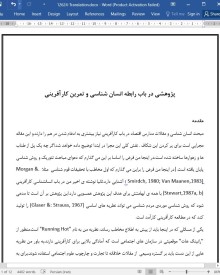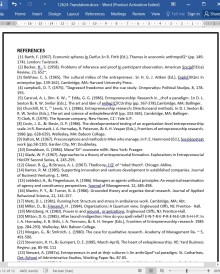
دانلود مقاله پژوهشی در باب رابطه انسان شناسی و تمرین کارآفرینی
مقدمه
مبحث انسان شناسی و مقالات مدارس اقتصاد در باب کارآفرینی نیاز بیشتری به ادغام شدن در هم را دارند.و این مقاله مجرایی است برای پر کردن این شکاف . نقش کلی این مجرا در ابتدا توضیح داده خواهد شد.اگر چه یک پل از طناب ها و زهوارها ساخته شده است،در اینجا من فرض را اساسا بر این می گذارم که دعوای مباحث تئوریک و روش شناسی پایان یافته است.|در اینجا من فرض را براین می گذارم که اول مخاطب با تحقیقات قوم شناسی مثلا Morgan &. Smirdch, 1980; Van Maanen,1983) ) آشنایی دارد.ثانیا نوشته ی اخیر من در باب انسانشناسی کارآفرینی (Stewart,1987a, b) با همه ی ابهامتش برای هدف این پژوهش همسویی دارد.این پژوهش بر آن است تا مدعی شود که روش شناسی موردی مردم شناسی می تواند نظریه های اساسی (Glaser &: Strauss, 1967) را تولید کند که در مطالعه کارآفرینی کارآمد است.
یکی از مسائلی که در اینجا باید از پیش به اطلاع مخاطب رساند، نظریه من به نام "Running Hot” است.منظور از "رانینگ هات" موقعیتی در سازمان های اجتماعی است که آمادگی بالایی برای کارآفرینی دارند.به باور من نظریه هایی از این دست باید بر گستره وسیعی از مقالات خلاقانه تا تجارت و چارچوب علوم اجتماعی استفاده شوند.برای به تصویر کشیدن استفاده مردم شناسی و اثبات این ادعا که نظریه رانینگ هات کارآفرین هست،طرحواره ای از این نظریه بر روی مردمشناسی کار آفرینی قرار خواهد گرفت.
به طور خلاصه:هدف از مطالعه موردی تحقیقات فهم دقیق این است که کدام مطالعه موردی حداقل خشونت را از منظر "مردم بومی" داراست.پژوهش خوشبینانه به مسئله نگاه می کند و صرفا درگیر بازی های تئوریک نمی شود. در حالی که تمرکز آن بر بومی ها هست اما تصویری جامع از محتوای مورد بحث ارائه می دهد به طوری که از یک مطالعه ی موردی صرف فراتر می رود.با در نظر گرفتن محدودیت ها این پژوهش راهی برای مقاله های گسترده تری پیرامون دیالکتیک بین مطالعه موردی و نظریه پردازی باز می شود.این دیالکتیک و همینطور خود زمینه کاری، رابطه ی بین صنایع و سنت کارآفرینی را مشخص می کند.این سنت ها استفاده وسیع از مقالات را شامل می شود.بعضی از این موارد مردم شناسانه است اما به طور کلی منظور تحقیق بر آن است که باید به قوم نگاری تجارت به صورت تخصصی نگاه کرد .در این صورت راهی به سوی یک نظریه چارچوب مند باز می شود که در نهایت به مقالات بازخورد می دهد.رانینگ هات برای نمونه بر این ادعا استوار است که سبک های اجرایی متفاوتی از کارآفرینی وجود دارد.چنین تئوری هایی در نهایت در عمل ، آموزش و نظریه پردازی تاثیرگذار هستند.همانطور که همه ی مردم شناس ها می دانند،تاریخ مردمشناسی نشان داده است که نمی توان بر روی صندلی راحتی نشست و مباحث پیچیده ی پدیده های اجتماعی را درک کرد.بلکه باید در زندگی هر روزه به جستجوی ان رفت. به عنوان مثال در تحقیقات در باب کسب و کار وارد شدن به زندگی غیر محافظت شده یک ضرورت است.فقط در صورتی که محقق به عنوان یک« شخص بومی »و عملگرا شناخته شود می تواند شاهد و مفسر فضای «واقعی» باشد.
به طور خلاصه شبیه یک «کار مدیریتی» است.به طوری که به عملگرایی می پردازد. فراتر از همه رانینگ هات دارای اشتیاق برای تمرکز بر حوزه ی مشتری و مشروعیت بخشیدن به این حوزه است.جای تعجب نیست که بازار در واکنش با رشد سریع و سود بسیار پاداش می دهد.این یکی دلایلی است که بازخورد این گراندد تئوری(grounded theory) در دانش تجارت است.از طرف دیگر می توان ادعا کرد که رانینگ هات یک فرم کارآفرین از کار مدیریتی است.خیلی کم پیش آمده که گزارش شود پروسه ی رانینگ هات بعد از به کارگیر ی و گذشتن از مراحل اولیه ناتمام مانده باشد.
(Carsrud, Olm, &. Eddy, 1986, pp. 368-369; Mitton, 1985; see also Van deVen etal., 1984) سایرین شروع به گسترش اندازه گیری کارآفرینی در سطح سازمانی کردند. (Covin &. Slevin, 1986). . اگر چه خیلی ساختارشکنانه است اگر ادعا کنیم که تمام فعالیت های روزانه یک کارخانه قطعات خودرو کارآفرین است. PP بخشی از یک طرح بزرگتر است که بسیار تصور می شود کارآفرین باشد، اما انطور که همه درباره ی آن به عنوان سازمان تعاونی و خلاق در حوزه ی کارآفرینی تصور می کنند نیست.این سنجش به صورت قابل تفهیمی می تواند در صفحات بعد نشان داده شود.از آنجا که ان نوشته بیشتر در باب پروسه ی تحقیق است تا یک مقاله در باب کارآفرینی، توصیف ها ممکن بسیار کوتاه شده باشند. رویکرد مردم شناسی سه تاثیر اصلی بر مطالعات کارآفرینی می گذارد.اول: یک شکل از سازمان های جمعی که بسیار برای کارآفرینی راهبر و همراه با رشد اقتصادی است پیشنهاد می دهد.دوم : قوم شناسی دستورالعملی را با جزئیات برای ق فهم رانینگ هات ارائه می دهد.( در Stewart, 1987c به آن اشاره شده است.) و در نتیجه بازده کم یا زیاد بیشتر می شود.سوم: دستورالعمل ارزش بازتولید را دارد،زیرا از لحاظ اقتصادی به صرفه هست.همچنین توجه مردمشناسی به دستورالعمل های اخلاقی این امکان را برای این ادعا که رانینگ هات از لحاظ اخلاقی موفق است فراهم می کند. ( همچنین نگاه شود به (Stewart, 1987b, c
INTRODUCTION
The anthropological and business school writings on entrepreneurship are much in need of bridging, and this essay is a strand across the chasm.' The particular role of this strand will first be explained. Although the bridge is constructed of rope, and rickety, I quixotically assume that the theoretical and methodological battles are over, and tilt at different windmills. In doing so I make two assumptions. flrst, that the audience has some familiarity with apologies for qualitative and ethnographic research (e.g. Morgan &. Smirdch, 1980; Van Maanen,1983). Second, that my recent interpretations of the anthropology of entrepreneurship (Stewart,1987a, b), while admittedly obscure, need only be summarized for the purpose of this paper. That purpose 15 to argue that the case-based methodology of the anthropologist can generate Hgrounded the0- ries" (Glaser &: Strauss, 1967) that contribute to entrepreneurial studies.
One purported contribution, the reader is forewarned, is my own grounded theory called "Running Hor. Running Hot is a mode of social organization that is highly conducive to ongoing entrepreneurship. Theories such as this, I believe, should be based on the creative use of a broad range of literatures from the business and sociaJ science disciplines. In order to demonstrate the use of anthropology, and to justify the claim that Running Hot is entrepreneurial, a sketch of the theory will be mapped against the anthropology of entrepreneurship.
In general terms, the basis is a community of work with much sociability and little size. This community iscreated with an informal, nonunionized internal labor market (llM). Such an ILM develops a plant-specific frame of reference for the game, and the network-based skills that make possible the mutual adjustment of the (nonprofessional) workforce. It also develops a high level of employee dependence upon the one employer. This dependence, in conjunction with both the -market discipline" (Oark, 1979) of close customer contact, and the skewing of technical competence to the apex, gives Running Hot its political character. This character is captured in two phrases; meritocratic autocracy, and the politics of competence". This latter phrase indicates that virtually all organizational politics are concerned with the individual competences to Run Hot; that is, are channelled within the mission of the firm.
In short, Running Hot is in many ways typical of "managerial work", in that it is action~riented, hectic, and pragmatic. However, it is distinguished above all for its passionate focus on the customer constituency and its success in legitimating this focus. Not surprisingly, then, the market has rewarded the firm with very fast growth and high profitability. This is one reason that this grounded theory feeds back into the general body of business knowledge. 7 Another is that it can be argued that Running Hot is an entrepreneurial fonn of managerial work. A very few writers have argued that entrepreneurial activity is not finished once a firm is past the initial startup phase (Carsrud, Olm, &. Eddy, 1986, pp. 368-369; Mitton, 1985; see also Van deVen etal., 1984). Othershave begun to develop organization-Ievel scales for measuring entrepreneurship (Covin &. Slevin, 1986). However, it is seemingly iconoclastic to claim that the everyday aclivilY of an auto parts plant is Nentrepreneurial". PressiriProd is part of a larger firm that is widely thought to be "entrepreneurial", but it is not what most people would think of as an internal corporate venture or an inn0- vative and -intrapreneurial" site. It does, I believe, exemplify the ongoing implementation of entrepreneurship, if we take as"our point of departure the anthropological literature. This comparison can most conveniently be demonstrated by the figure on the following page. Since this paper is about the research process, rather than the content of the anthropological literature or of Running Hot, the figure may seem too concise. This example of the use of anthropological approaches has three main implications for entrepreneuria1 studies. First, It proposes a form 01 sociaJ organization that is highly conducive to entrepreneurship and economic growth. Second, ethnography unravels the configuration In considerable detail (that is,ln Stewart, 1987c), so that Running Hot is understandable, and therefore, more-or-Iess reproducible. Third, the configuration is worth reproducing. since it is financially successful. The anthropological concern with moral orders and moral ambiguities of entrepreneurship makes it possible also to argue that Running Hot is morally sui:cessful (see also Stewart, 1987b, c).
- اصل مقاله انگلیسی با فرمت ورد (word) با قابلیت ویرایش
- ترجمه فارسی مقاله با فرمت ورد (word) با قابلیت ویرایش، بدون آرم سایت ای ترجمه
- ترجمه فارسی مقاله با فرمت pdf، بدون آرم سایت ای ترجمه


